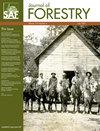Current understanding and future prospects for ash dieback disease with a focus on Britain
IF 3.2
2区 农林科学
Q1 FORESTRY
引用次数: 0
Abstract
Hymenoscyphus fraxineus is an introduced ascomycete fungus which causes ash dieback and has resulted in widespread mortality of ash throughout Europe. Although H. fraxineus has been present on the continent for at least four decades, it was not identified until 2006. The first record of the pathogen in Britain came in 2012 although it was probably present a decade earlier. The most common host European ash (Fraxinus excelsior L.) is economically and ecologically important to Britain where the cost of ash dieback is estimated at billions of pounds. The impact of ash dieback has stimulated a major research response which we review with the aim of providing up-to-date information relevant to Britain and identifying knowledge gaps where research would contribute to improved disease mitigation. Hymenoscyphus fraxineus is an outcrossing fungus with high genotypic diversity; ascospores produced via sexual reproduction are critical to aerial dispersal and infection. Temperature, moisture, and ground cover influence pathogen fruit body development, the timing of ascospore release, and extent of ascospore germination; they also interact together to affect the likelihood of infection. In addition, stand characteristics, including tree density, tree height, and landscape fragmentation, affect disease dynamics with increased disease severity on moist sites with high ash density. Efforts at finding natural resistance in ash have identified genetic markers associated with disease tolerance, and gene expression analysis is providing insights into the basis of that resistance. Mainland European findings indicate that ash dieback makes trees more vulnerable to other pathogens, whilst endophytes in the ash phyllosphere can suppress infection by H. fraxineus. Possible tools for long-term control of ash dieback include (1) deployment of resistant ash, (2) quantitatively informed management practices based on microclimate models and better understanding of the pathogen life cycle, and (3) manipulation of biocontrol agents from the ash microbiome or pathogen mycoviruses.对白蜡枯萎病的当前认识和未来展望,重点是英国
fraxineus 真菌是一种外来的子囊菌,会导致白蜡树枯死,并造成欧洲各地白蜡树大面积死亡。虽然 H. fraxineus 在欧洲大陆至少存在了 40 年,但直到 2006 年才被发现。该病原体在英国的首次记录是在 2012 年,尽管它很可能在十年前就已经存在。最常见的寄主欧洲白蜡(Fraxinus excelsior L.)对英国具有重要的经济和生态意义,白蜡树枯死造成的损失估计高达数十亿英镑。白蜡树枯死的影响引发了一项重大研究,我们对这项研究进行了回顾,目的是提供与英国相关的最新信息,并找出知识差距,以便通过研究改善病害缓解工作。白蜡疫霉菌(Hymenoscyphus fraxineus)是一种外交真菌,具有高度的基因型多样性;通过有性生殖产生的 ascospores 对空中传播和感染至关重要。温度、湿度和地面覆盖会影响病原体子实体的发育、腹孢子释放的时间和腹孢子发芽的程度;它们还会相互作用,影响感染的可能性。此外,林分特征(包括树木密度、树高和景观破碎化)也会影响病害动态,在白蜡树密度高的潮湿地区,病害的严重程度会增加。为寻找白蜡树的天然抗病性所做的努力已经确定了与疾病耐受性相关的遗传标记,基因表达分析正在为了解这种抗病性的基础提供帮助。欧洲大陆的研究结果表明,白蜡树的枯萎病使树木更容易受到其他病原体的侵害,而白蜡树叶球中的内生菌可以抑制 H. fraxineus 的感染。长期控制白蜡树枯梢病的可能手段包括:(1)种植抗性白蜡树;(2)根据小气候模型和对病原体生命周期的更好了解,采取定量的管理措施;(3)利用白蜡树微生物组或病原体霉菌病毒中的生物控制剂。
本文章由计算机程序翻译,如有差异,请以英文原文为准。
求助全文
约1分钟内获得全文
求助全文
来源期刊

Forestry
农林科学-林学
CiteScore
6.70
自引率
7.10%
发文量
47
审稿时长
12-24 weeks
期刊介绍:
The journal is inclusive of all subjects, geographical zones and study locations, including trees in urban environments, plantations and natural forests. We welcome papers that consider economic, environmental and social factors and, in particular, studies that take an integrated approach to sustainable management. In considering suitability for publication, attention is given to the originality of contributions and their likely impact on policy and practice, as well as their contribution to the development of knowledge.
Special Issues - each year one edition of Forestry will be a Special Issue and will focus on one subject in detail; this will usually be by publication of the proceedings of an international meeting.
 求助内容:
求助内容: 应助结果提醒方式:
应助结果提醒方式:


